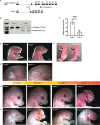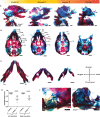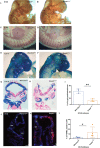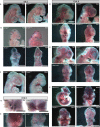Snrpb is required in murine neural crest cells for proper splicing and craniofacial morphogenesis
- PMID: 35593225
- PMCID: PMC9235875
- DOI: 10.1242/dmm.049544
Snrpb is required in murine neural crest cells for proper splicing and craniofacial morphogenesis
Abstract
Heterozygous mutations in SNRPB, an essential core component of the five small ribonucleoprotein particles of the spliceosome, are responsible for cerebrocostomandibular syndrome (CCMS). We show that Snrpb heterozygous mouse embryos arrest shortly after implantation. Additionally, heterozygous deletion of Snrpb in the developing brain and neural crest cells models craniofacial malformations found in CCMS, and results in death shortly after birth. RNAseq analysis of mutant heads prior to morphological defects revealed increased exon skipping and intron retention in association with increased 5' splice site strength. We found increased exon skipping in negative regulators of the P53 pathway, along with increased levels of nuclear P53 and P53 target genes. However, removing Trp53 in Snrpb heterozygous mutant neural crest cells did not completely rescue craniofacial development. We also found a small but significant increase in exon skipping of several transcripts required for head and midface development, including Smad2 and Rere. Furthermore, mutant embryos exhibited ectopic or missing expression of Fgf8 and Shh, which are required to coordinate face and brain development. Thus, we propose that mis-splicing of transcripts that regulate P53 activity and craniofacial-specific genes contributes to craniofacial malformations. This article has an associated First Person interview with the first author of the paper.
Keywords: SNRPB; Cerebrocostomandibular syndrome; Craniofacial; Neural crest cells; Splicing.
© 2022. Published by The Company of Biologists Ltd.
Conflict of interest statement
Competing interests The authors declare no competing or financial interests.
Figures







Similar articles
-
Spliceosomopathies and neurocristopathies: Two sides of the same coin?Dev Dyn. 2020 Aug;249(8):924-945. doi: 10.1002/dvdy.183. Epub 2020 May 21. Dev Dyn. 2020. PMID: 32315467 Review.
-
Craniofacial Defects in Embryos with Homozygous Deletion of Eftud2 in Their Neural Crest Cells Are Not Rescued by Trp53 Deletion.Int J Mol Sci. 2022 Aug 12;23(16):9033. doi: 10.3390/ijms23169033. Int J Mol Sci. 2022. PMID: 36012294 Free PMC article.
-
Mutations in SNRPB, encoding components of the core splicing machinery, cause cerebro-costo-mandibular syndrome.Hum Mutat. 2015 Feb;36(2):187-90. doi: 10.1002/humu.22729. Epub 2014 Dec 11. Hum Mutat. 2015. PMID: 25504470
-
The Core Splicing Factors EFTUD2, SNRPB and TXNL4A Are Essential for Neural Crest and Craniofacial Development.J Dev Biol. 2022 Jul 8;10(3):29. doi: 10.3390/jdb10030029. J Dev Biol. 2022. PMID: 35893124 Free PMC article.
-
A review of craniofacial disorders caused by spliceosomal defects.Clin Genet. 2015 Nov;88(5):405-15. doi: 10.1111/cge.12596. Epub 2015 May 1. Clin Genet. 2015. PMID: 25865758 Review.
Cited by
-
Human stem cell model of neural crest cell differentiation reveals a requirement of SF3B4 in survival, maintenance, and differentiation.bioRxiv [Preprint]. 2024 May 2:2024.01.25.577202. doi: 10.1101/2024.01.25.577202. bioRxiv. 2024. Update in: Dev Dyn. 2025 Mar 6. doi: 10.1002/dvdy.70009. PMID: 38328054 Free PMC article. Updated. Preprint.
-
Deletion of sf3b4 causes splicing defects and gene dysregulation that disrupt craniofacial development and survival.Dis Model Mech. 2025 Mar 1;18(3):dmm052169. doi: 10.1242/dmm.052169. Epub 2025 Mar 24. Dis Model Mech. 2025. PMID: 40126363 Free PMC article.
-
SNRPB/CCNB1 axis promotes hepatocellular carcinoma progression and cisplatin resistance through enhancing lipid metabolism reprogramming.J Exp Clin Cancer Res. 2025 Jul 18;44(1):211. doi: 10.1186/s13046-025-03463-y. J Exp Clin Cancer Res. 2025. PMID: 40682115 Free PMC article.
-
Identification of pararosaniline as a modifier of RNA splicing in Caenorhabditis elegans.G3 (Bethesda). 2023 Dec 6;13(12):jkad241. doi: 10.1093/g3journal/jkad241. G3 (Bethesda). 2023. PMID: 37852248 Free PMC article.
-
The unfolded protein response regulates ER exit sites via SNRPB-dependent RNA splicing and contributes to bone development.EMBO J. 2024 Oct;43(19):4228-4247. doi: 10.1038/s44318-024-00208-z. Epub 2024 Aug 19. EMBO J. 2024. PMID: 39160274 Free PMC article.
References
-
- Bacrot, S., Doyard, M., Huber, C., Alibeu, O., Feldhahn, N., Lehalle, D., Lacombe, D., Marlin, S., Nitschke, P., Petit, F.et al. (2015). Mutations in SNRPB, encoding components of the core splicing machinery, cause cerebro-costo-mandibular syndrome. Hum. Mutat. 36, 187-190. 10.1002/humu.22729 - DOI - PubMed
-
- Beauchamp, M.-C., Djedid, A., Bareke, E., Merkuri, F., Aber, R., Tam, A. S., Lines, M. A., Boycott, K. M., Stirling, P. C., Fish, J. L.et al. (2021). Mutation in Eftud2 causes craniofacial defects in mice via mis-splicing of Mdm2 and increased P53. Hum. Mol. Genet. 30, 739-757. 10.1093/hmg/ddab051 - DOI - PMC - PubMed
-
- Bogue, M. A., Grubb, S. C., Walton, D. O., Philip, V. M., Kolishovski, G., Stearns, T., Dunn, M. H., Skelly, D. A., Kadakkuzha, B., TeHennepe, G.et al. (2018). Mouse Phenome Database: an integrative database and analysis suite for curated empirical phenotype data from laboratory mice. Nucleic Acids Res. 46, D843-D850. 10.1093/nar/gkx1082 - DOI - PMC - PubMed
Publication types
MeSH terms
Substances
Supplementary concepts
Grants and funding
LinkOut - more resources
Full Text Sources
Medical
Molecular Biology Databases
Research Materials
Miscellaneous

